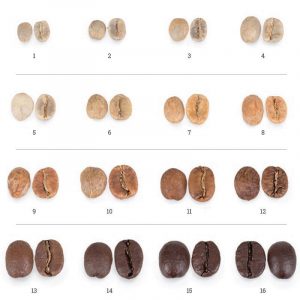During roasting, beans’ physical and chemical properties undergo several changes:
- Physical reactions
- Water evaporation
- Increase of inner pressure
- First crack
- Increase in volume (50% – 100%)
- Mass loss (12% – 24%)
- Chaff formation
- Carbon dioxide release
- Second crack
- Chemical reactions
- Pyrolytic reactions
- Maillard reactions
- Strecker decomposition
- Caramelization
- Hydrolysis
- Oxidation
What is the first crack ?
During roasting, moisture begins to evaporate, and the bean expands. Besides the water vapor, gases released as the output of exothermic reactions build up extra pressure. Expanded gases and vapor, trapped inside the bean, escape by cracking the cellulose structure which is called first crack. First crack always occurs at 160 °C, where roasting temperature should not be increased.
What is the second crack ?
After the first crack, gas release continues, and pressure restarts to be built up inside the bean cells. Immediately, bean structure becomes more fragile. Though primary reason of the first crack is the water vapor accumulation, the second crack’s is the increase of carbon dioxide by volume during roasting.
toperroasters coffee roasting, grinding and destoner machines.





